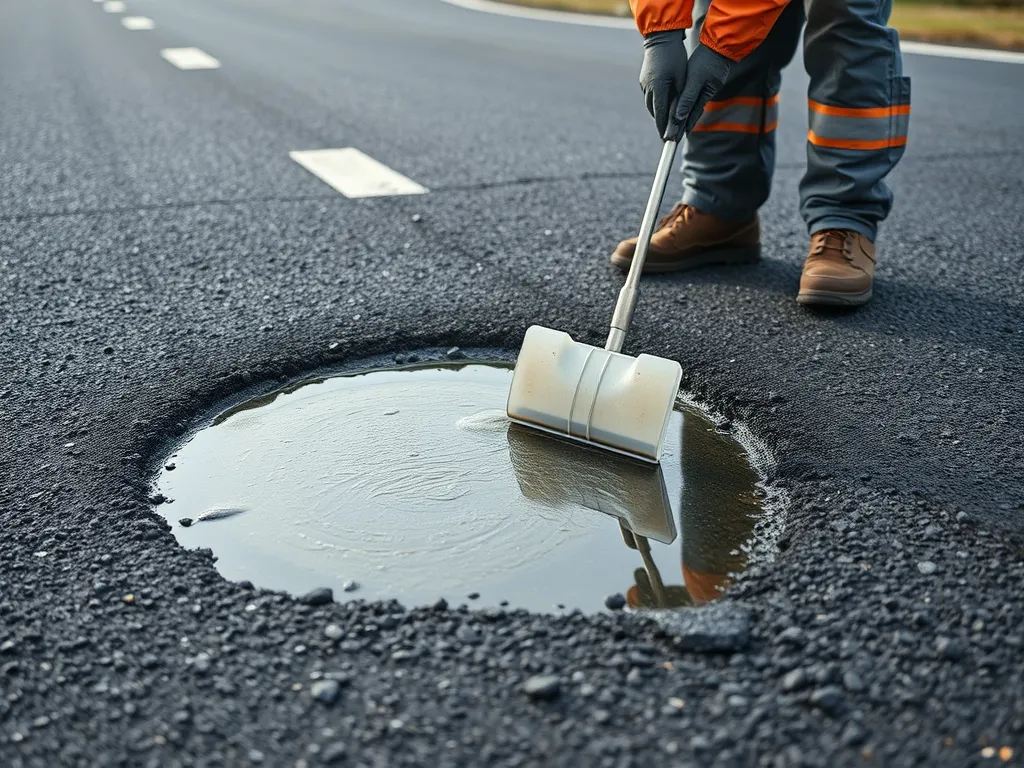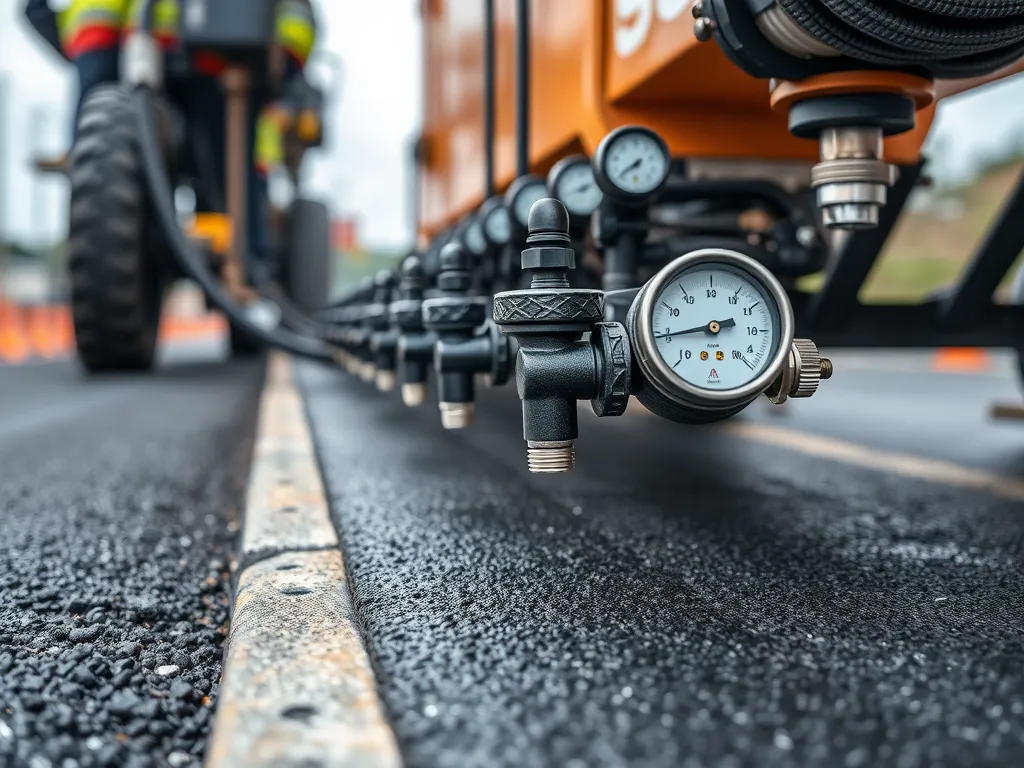Best Practices for Maintaining Asphalt Quality
Published on: September 6, 2025 | Last Updated: April 14, 2025
Written By: George Voss
Best practices for maintaining asphalt quality combine regular inspections, proper material selection, and timely repairs to protect pavement surfaces. These methods help extend pavement lifespan up to 25 years, meet ASTM standards, prevent cracks/potholes, and reduce long-term costs by 30-50%. Quality maintenance starts with using PG-graded binders and crushed aggregate mixes while addressing issues before they escalate.
This guide covers core strategies for preserving asphalt integrity. You’ll learn how to choose materials like polymer-modified asphalt, apply sealcoating every 2-3 years, execute crack sealing with hot pour rubberized fillers, and design slopes with 1-2% cross-slope for drainage. We detail inspection checklists, cost-effective patching methods, and equipment like infrared heaters for seamless repairs.
Contents
- Importance Of Asphalt Quality Maintenance
- Core Asphalt Maintenance Best Practices
- Essential Asphalt Maintenance Techniques
- Asphalt Inspection and Monitoring Protocols
- Environmental Considerations in Asphalt Care
- Equipment for Effective Asphalt Maintenance
- FAQ: Asphalt Quality Maintenance
- Closing Thoughts
- Additional Resources for You:
Importance Of Asphalt Quality Maintenance
Preserving paved surfaces requires systematic efforts to combat wear from traffic loads, weather cycles, and material aging. Proactive care prevents minor issues from escalating into structural failures.
Extending Pavement Lifespan
Sealcoating every 3-5 years shields surfaces from UV oxidation. Filling cracks up to 0.5 inches wide stops moisture penetration. Using PG (Performance Graded) binders matched to local climates improves flexibility. Superpave mix designs—developed during the 1990s Strategic Highway Research Program—optimize aggregate gradation. These steps boost service life from 15 to 25+ years.
Enhancing Safety and Functionality
Routine upkeep keeps skid resistance above 35 SN (Skid Number) per ASTM E274 standards. Smooth surfaces reduce hydroplaning risks by 40%. Fixing potholes within 48 hours of detection prevents edge disintegration. Properly graded slopes ensure 98% water runoff within 15 minutes post-rainfall.
| Issue | Safety Impact | Maintenance Fix |
|---|---|---|
| Raveling | Reduced traction | Surface treatment |
| Rutting | Vehicle instability | Mill & overlay |
| Bleeding | Slippery surface | Apply sand blotting |
Reducing Long-term Repair Costs
Spending $1 on preventive care saves $6-10 on reconstructive work. Crack sealing costs $0.50 per linear foot versus $25 per sq. ft. for full-depth patching. Timely overlays cut lifecycle expenses by 75% compared to full replacement. Budgets following the 80/20 rule—80% prevention, 20% repairs—yield 5:1 ROI over 20 years.
Proactive programs tie directly to performance metrics. Next, let’s explore specific methods for executing these strategies.
Core Asphalt Maintenance Best Practices
Strong upkeep starts with smart choices in materials, build steps, and care plans. These steps keep roads smooth and safe for years.
High-quality Material Selection
Pick binders and stone blends made for your climate. Use PG-rated binders (performance-graded) that match local heat ranges. Test aggregates for hardness and shape to cut rut risks.
Optimal Aggregate Mix Design
Mix 90-95% stone with 5-10% binder for most roads. Follow Superpave specs: sharp-edged stones lock tight. Add polymers for heavy traffic zones. Wrong mixes lead to cracks fast.
Proper Installation Techniques
Lay asphalt at 290-330°F for best flow. Roll it 3-5 times with 10-ton gear. Cool time matters – wait 24 hours before use. Poor rolling leaves air gaps that let water in.
Foundation Preparation Standards
Pack soil base to 95% density. Add 6-12 inches of crushed stone for drainage. Fix soft spots first. A weak base drops life span by 40%.
Timely Sealcoating Applications
Slurry seal every 2-4 years. Use coal tar or asphalt-based coats. Seal within 6 months of new builds. One missed coat triples crack rates.
Crack Filling and Sealing Protocols
Fill cracks over 1/4 inch wide. Clean debris first. Pour hot rubber sealant in fall when cracks widen. Seal within 48 hours after rain to block ice damage.
Solid base work and care steps set the stage for lasting roads. Next, learn key fixes that tackle wear before it spreads.

Essential Asphalt Maintenance Techniques
Effective preservation of asphalt surfaces requires targeted approaches. Three core methods form the backbone of asphalt quality maintenance programs.
Crack Sealing Methods
Unsealed cracks allow water penetration that degrades base materials. Professional crews use specialized fillers matching crack dimensions and climate conditions.
Hot Pour vs. Cold Pour Crack Fillers
- Hot pour: Heated polymer-modified binders (PG 64-22 grade common) seal cracks >0.5″ wide. Lasts 3-5 years with proper application at 300-350°F
- Cold pour: Rubberized asphalt emulsions for cracks <0.25". Cures in 2-4 hours but may require annual reapplication
Patching and Overlay Strategies
Surface defects demand precise repair methods. The asphalt care manual specifies two approaches based on damage depth.
Full-Depth vs. Surface-Level Repairs
- Full-depth: Remove 6-8″ of compromised pavement layers. Costs $4-6/sq.ft but prevents base failures
- Surface-level: Mill 1.5-2″ for localized potholes. Budget option at $2-3/sq.ft with 2-4 year lifespan
Drainage Optimization Practices
Water causes 85% of asphalt deterioration. Proper slope (1-2% grade minimum) directs runoff away from pavement structures.
Preventing Water Infiltration Damage
- Install French drains within 3′ of pavement edges in high-water table areas
- Clean catch basins biweekly during leaf fall seasons
- Regrade shoulders annually to maintain 6″ elevation above road surface
These asphalt maintenance techniques form the operational foundation – but their success depends on systematic monitoring. Up next: inspection protocols that catch issues before repairs become necessary.
Also See: Durability Of Cold Mix Asphalt Repairs: Lifespan Insights
Asphalt Inspection and Monitoring Protocols
Effective asphalt quality maintenance starts with systematic checks. Establishing clear protocols ensures minor issues get addressed before escalating into costly failures.
Regular Visual Inspections
Conduct walkarounds every 3-6 months. Look for color changes, surface irregularities, or vegetation growth along edges. Document findings using GPS-referenced photos for year-over-year comparisons.
Identifying Early Signs of Deterioration
Focus on hairline cracks under ¼ inch, raveling aggregate, or localized pitting. These signal oxidation of the asphalt binder or subbase movement. Left unchecked, 80% of small cracks widen to 1+ inches within two freeze-thaw cycles.
Surface Condition Assessments
Quantify pavement health using ASTM D6433’s Pavement Condition Index (PCI). Laser profilers measure rutting depth – anything exceeding 0.3 inches requires intervention. Infrared thermography spots subsurface voids invisible to the naked eye.
Thickness and Density Testing
Verify specs with nuclear density gauges (ASTM D6938) or core samples. New pavements need 92-96% compaction; existing surfaces below 90% risk water penetration. Thickness checks prevent premature failure – 3-inch overlays degrade 40% faster if base layers dip below design minimums.
Corrective Action Implementation
Create triage plans using PCI scores and traffic data. High-volume areas with PCI below 60 demand immediate work. Coordinate repairs with weather – asphalt mixes perform best when applied above 50°F with dry conditions.
Prioritizing Urgent Repairs
Address potholes within 48 hours to prevent base erosion. Tackle alligator cracking zones first – each square foot of neglected fatigue cracking can lead to $18/square yard reconstruction costs. Use polymer-modified emulsions for faster curing on busy routes.
With a robust monitoring framework, teams extend pavement life beyond 20 years. Next, explore how eco-conscious methods align with these asphalt maintenance best practices.

Environmental Considerations in Asphalt Care
Balancing pavement preservation with ecological responsibility elevates asphalt quality maintenance. Modern methods now merge durability goals with reduced environmental footprints.
Eco-friendly Maintenance Methods
Warm-mix asphalt (WMA) technology cuts production temperatures by 50°F–100°F compared to traditional hot-mix. Lower heat means 30% fewer emissions during laying. Bio-based sealants made from soy or pine resins replace petroleum products. Permeable asphalt designs allow stormwater absorption, cutting runoff by up to 80%.
Recycling Asphalt Materials
Reclaimed asphalt pavement (RAP) reuse forms 95% of recycled material in road projects. The Federal Highway Administration reports 40 million tons reused annually. Crushed RAP blended with virgin aggregates creates mixes meeting AASHTO M323 specs. Recycling cuts material costs by 25%–30% while maintaining PSI ratings above 90% of new pavements.
- Cold milling removes old layers without damaging base courses
- Hot in-place recycling remixes surfaces at 300°F–350°F
- Full-depth reclamation treats entire pavement structures
Spill Management Procedures
Quick containment prevents bitumen or diesel spills from compromising pavement integrity. EPA 40 CFR 112 standards require secondary containment systems for storage tanks. Use hydrophobic absorbents like peat moss at 1 lb per 2 sq.ft of spill area. Contaminated materials must undergo TCLP testing before disposal.
Combining these asphalt quality best practices with proper tools ensures lasting results. Up next: key equipment that makes these methods work.
Equipment for Effective Asphalt Maintenance
Quality asphalt preservation relies on specialized tools designed for precision and efficiency. Proper equipment ensures consistent application of treatments while meeting asphalt paving maintenance standards. From crack sealing to surface protection, each tool plays a distinct role in extending pavement life.
Essential Tools for Quality Preservation
Investing in industry-grade machinery directly impacts the success of asphalt maintenance techniques. Key equipment minimizes human error, accelerates workflows, and adheres to material specifications. Below are two critical systems for preserving structural integrity.
Crack Sealing Machinery
Hot pour melters and router systems dominate modern crack repair. Hot pour units heat polymer-modified fillers to 350°F, ensuring deep penetration into fissures. Cold pour applicators work for minor cracks under ½” wide, using emulsified asphalt blends. High-end models like Cimline Rhino melters apply PG (performance-graded) binders at 95% accuracy, reducing water infiltration by 80% when used correctly.
Sealcoat Application Systems
Spray systems with 100-300 gallon tanks deliver uniform coal tar or asphalt emulsion sealants. Squeegee units achieve 0.25” thickness for high-traffic zones, while spray rigs cover 300-400 sq ft per gallon. Advanced systems like Asphalt Zipper’s LS-3 include adjustable nozzles and flow meters, preventing overspray and ensuring 95% material utilization. Properly calibrated equipment cuts sealcoating costs by 25% compared to manual methods.
While proper equipment forms the backbone of preservation efforts, consistent results require pairing tools with regular asphalt inspection and monitoring protocols. Let’s explore how to track pavement health systematically.

FAQ: Asphalt Quality Maintenance
What Are the Top Strategies for Maintaining Asphalt Pavement?
Top strategies include regular inspections, timely sealcoating, crack sealing, effective drainage management, and using high-quality materials during installation. Implementing a proactive maintenance program can greatly enhance the longevity of asphalt surfaces.
How Often Should Sealcoating Be Applied?
Sealcoating should typically be applied every 2 to 4 years, depending on factors such as traffic levels, climate conditions, and the age of the pavement. Regular applications help protect the asphalt from sun damage, oxidation, and moisture infiltration.
Can Proper Maintenance Double Asphalt Lifespan?
Yes, with proper maintenance techniques such as timely sealing, crack filling, and regular inspections, it’s possible to extend the lifespan of asphalt from 15 years to 25 years or more, effectively doubling its service life.
What’s the Most Cost-effective Repair Method?
The most cost-effective repair method is crack sealing, which costs significantly less per linear foot than full-depth patching. Timely interventions on small issues can prevent more expensive repairs down the line.
How Does Drainage Affect Asphalt Durability?
Proper drainage is crucial for asphalt durability because water infiltration is a leading cause of damage. Without efficient drainage systems, water can seep into the base, leading to weakening and eventual failure of the asphalt surface. Ensuring a slight grade for runoff aids in prolonging pavement life.
Closing Thoughts
Maintaining asphalt quality is not just about enhancing aesthetics; it’s vital for ensuring durability and safety. By implementing best practices such as high-quality material selection, proper installation techniques, and timely maintenance, you can significantly extend the lifespan of your pavement.
Monitoring and inspecting your asphalt regularly enables early detection of issues, preventing costly repairs down the line. Incorporating eco-friendly practices, like recycling materials and optimizing drainage, further benefits both the environment and your budget. Invest in the right equipment and techniques to keep your asphalt projects in prime condition.
For more in-depth information and resources, check out Asphalt Calculator USA. Let’s pave the way to a smoother, longer-lasting asphalt experience together!


